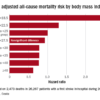![1]()
News
Obesity paradox applies to post-stroke mortality
January 17, 2019
CHICAGO – Overweight and obese VA stroke patients have lower 30-day and 1-year all-cause mortality after an in-hospital stroke.
![1]()
News
Prioritize oral route for inpatient opioids with subcutaneous route as alternative
January 16, 2019
Can adoption of a local opioid standard of practice for hospitalized patients reduce intravenous and overall opioid exposure while providing effective pain control?
![1]()
News
RE-SPECT ESUS: Dabigatran matched aspirin for second stroke prevention
January 9, 2019
MONTREAL – In an international trial with 5,390 patients, dabigatran proved no better than aspirin for second stroke prevention following ESUS.
News
AAN publishes position statement on brain death
January 8, 2019
The association calls for uniform laws and policies regarding brain death, as well as continued research and public education.
News
Synthetic opioids drive spike in U.S. fatal drug overdoses
January 4, 2019
Spurned by physicians, more users seem to be turning to street drugs that contain fentanyl and similar substances.
![1]()
News
How can I improve opioid safety at my hospital?
January 3, 2019
Quality improvement is essential.
News
No change in postoperative pain with restrictive opioid protocol
December 27, 2018
The implementation of an ultrarestrictive opioid prescribing protocol after gynecologic surgery was associated with significant declines in opioid use.
![1]()
News
Can higher MAP post cardiac arrest improve neurologic outcomes?
December 21, 2018
CHICAGO – A target mean arterial pressure higher than what the guidelines recommend appears safe but has mixed results for improving neurologic outcomes.
![1]()
News
Opioid benefit small in chronic noncancer pain
December 18, 2018
In a systematic review and meta-analysis, the reduction in chronic noncancer pain from opioids versus placebo was significant but small, and receded with time.
![1]()
News
Digital alerts reduced AF-related stroke, MI rates
December 18, 2018
CHICAGO – A computerized decision support system increased anticoagulation rates and reduced cardiac event rates in at-risk atrial fibrillation patients.






